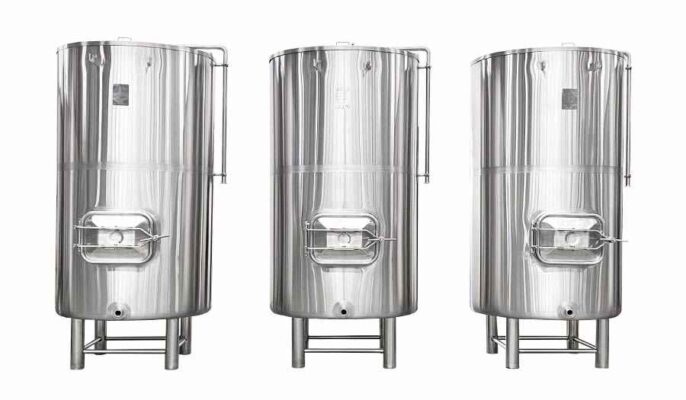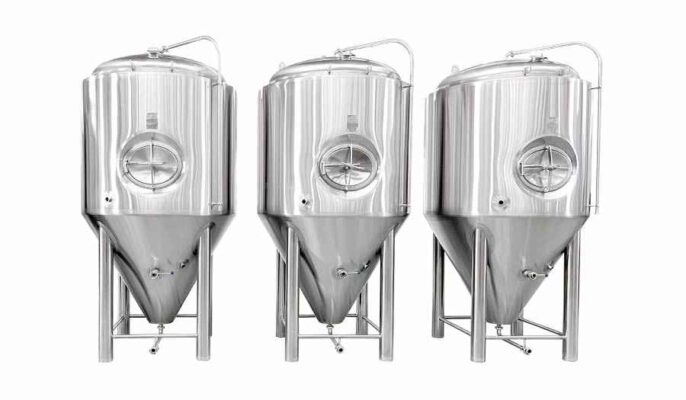I ty nejmenší detaily mohou mít na proces vaření velký vliv. Každá malá změna, kterou provedete v procesu vaření, může někde na trase vyvolat motýlí efekt a zcela změnit produkt. Při rozhodování o procesu a vybavení buďte velmi opatrní. Citlivá povaha procesu vaření piva je důvodem, proč je jeho vybavení tak důležité a je třeba se . Pro kvašení, zrání nebo dozrávání jsou dobrou volbou jak Brite tanky, tak Unitanky. Je třeba zvážit několik faktorů. V tomto článku se dozvíte, jaké jsou rozdíly mezi tanky Brite a Unitanks, abyste se mohli rozhodnout informovaněji.
Co je Bright Tank?
Mezi Bright Tank a Unitanků, lze tvrdit, že Bright Tank má jednodušší konstrukci. největším a nejpřímějším rozdílem mezi britským tankem a Unitankem je jejich tvar. Bright Tank má velmi jednoduchou válcovou konstrukci s plochým dnem. Ploché dno není pro proces kvašení tak vhodné jako kónické dno monokoků, ale pivní kanystry jsou stále skvělé pro skladování vyzrálého piva nebo pro uchovávání piva v době, kdy čeká na zabalení.

Co je Unitank?
Jak jsme již zmínili, hlavní rozdíl mezi nádrží Unitank a nádrží Brite Tank spočívá ve tvaru dna. Unitanks jsou také válcové nádrže, ale místo plochého dna mají dno kónické. Kuželovitý tvar umožňuje, aby se kvasinky hromadily v prostoru u dna. Díky této vlastnosti jsou unitanky vynikající volbou pro kvašení a zrání, protože kvasinky můžete po ukončení kvašení odfiltrovat.
Výhody nádrže Brite Tank
Kvašení v nádobě na kvasnice je možné, ale formát znesnadňuje vyjmutí kvasnic. Proto se obvykle používají pouze pro zrání a kvašení a jako prostor pro uložení piva před balením nebo prodejem.
Zvýšení výroby piva
Pro pivovary, které vyrábějí velké množství piva, mohou být plechovky nejlepší volbou. větší pivovary kvasí pivo v jednom prostoru a podávají nebo balí ho v jiném. Použitím brite tanku můžete zkvašené pivo převést z kvasného tanku, který zabírá, a tím uvolnit tento kvasný tank pro příjem a spuštění další várky piva při servírování nebo balení z brite tanku. To znamená, že lze vyrobit více dávek za kratší dobu.
Zlepšení čistoty piva
Do tanku Brite se obvykle ukládá pivo poté, co po určitou dobu kvasilo v samostatném tanku. Vzhledem k tomu, že kvasnice jsou před přenesením do pivních tanků ke zrání odfiltrovány, bude váš konečný produkt mnohem čirší než pivo zrající se zbytky kvasnic. Některé pivovary dávají přednost této čistší kvalitě.
Náhražky jsou levnější
V případě potřeby vyměňte nádrže používané ke kvašení a zrání. V takovém případě bývají tanky Brite levnější, protože mají jednodušší konstrukci a slouží pouze k jedné funkci. Výměna tanků Union stojí více než výměna tanků British.
Výhody Unitank
Výhodou používání Unitanku je jeho všestrannost. Lze ji použít pro mnoho částí procesu vaření piva, takže může snížit náklady na samostatné zařízení od prostředníka, které někteří považují za zbytečné.
Jednodušší proces vaření
Možnost kombinovat procesy zrání a kvašení zlepšuje vývoj tím, že eliminuje jeden proces. Ušetří se místo, protože nejsou potřeba dvě samostatné nádrže na vodu. To také znamená, že se pivo nemusí tolik přemisťovat, protože se musí převést do samostatného tanku, což šetří čas a námahu.
Nižší riziko kontaminace
Jednou z nejdůležitějších věcí, které je třeba při vaření piva zvážit, je riziko kontaminace, které mohou způsobit vnější organismy nebo samotný vzduch. Při každém vyjmutí piva z nádoby je pivo vystaveno působení volného vzduchu, čímž vzniká zkapalněný kyslík. I když tyto mikroorganismy nejsou obvykle smrtelné, mohou způsobit špatnou chuť piva, což je to poslední, co byste chtěli.

Jak si vybrat mezi nádržemi?
Kdy zvolit Unitank?
Unitanky jsou ideální pro malé pivovary nebo pivotéky. V těchto zařízeních je často omezený prostor, pivovary vyrábějí méně sudů piva a méně se zaměřují na balení a více na přímé podávání piva. Kombinované plechovky se v těchto situacích dobře osvědčují, protože šetří místo a pracovní sílu, aniž by snižovaly produktivitu jednotlivých balicích týmů.
Kdy zvolit plechovky na pivo Brite?
Plechovky Brite jsou vhodnější pro velkovýrobu, zejména pro ty, kteří se spoléhají na balení a přepravu většiny svých výrobků. Brite cisterny umožňují otevřít více kvasných nádob najednou. A protože plechovky pojmou najednou více tekutiny, mohou produkovat větší výtěžnost piva. Pokud jste překročili své limity a vaříte více sudů piva než minipivovar, možná by bylo dobré se poohlédnout po britských pivních tancích.




